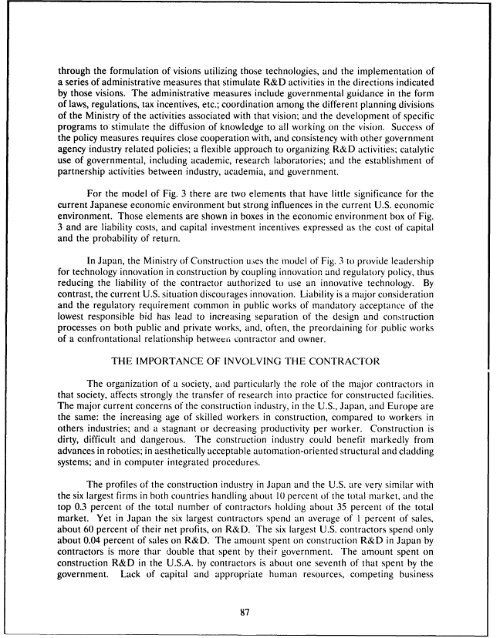Challenges and Opportunities for Innovation in the Public Works ...
Challenges and Opportunities for Innovation in the Public Works ...
Challenges and Opportunities for Innovation in the Public Works ...
Create successful ePaper yourself
Turn your PDF publications into a flip-book with our unique Google optimized e-Paper software.
through <strong>the</strong> <strong>for</strong>mulation of visions utiliz<strong>in</strong>g those technologies, <strong>and</strong> <strong>the</strong> implementation of<br />
a series of adm<strong>in</strong>istrative measures that stimulate R&D activities <strong>in</strong> <strong>the</strong> directions <strong>in</strong>dicated<br />
by those visions. The adm<strong>in</strong>istrative measures <strong>in</strong>clude governmental guidance <strong>in</strong> <strong>the</strong> <strong>for</strong>m<br />
of laws, regulations, tax <strong>in</strong>centives, etc.; coord<strong>in</strong>ation among <strong>the</strong> different plann<strong>in</strong>g divisions<br />
of <strong>the</strong> M<strong>in</strong>istry of <strong>the</strong> activities associated with that vision; <strong>and</strong> <strong>the</strong> development of specific<br />
programs to stimulate <strong>the</strong> diffusion of knowledge to all work<strong>in</strong>g on <strong>the</strong> vision. Success of<br />
<strong>the</strong> policy measures requires close cooperation with, <strong>and</strong> consistency with o<strong>the</strong>r government<br />
agency <strong>in</strong>dustry related policies; a flexible approach to organiz<strong>in</strong>g R&D activities; catalytic<br />
use of governmental, <strong>in</strong>clud<strong>in</strong>g academic, research laboratories; <strong>and</strong> <strong>the</strong> establishment of<br />
partnership activities between <strong>in</strong>dustry, academia, <strong>and</strong> government.<br />
For <strong>the</strong> model of Fig. 3 <strong>the</strong>re are two elements that have little significance <strong>for</strong> <strong>the</strong><br />
current Japanese economic environment but strong <strong>in</strong>fluences <strong>in</strong> <strong>the</strong> current U.S. economic<br />
environment. Those elements are shown <strong>in</strong> boxes <strong>in</strong> <strong>the</strong> economic environment box of Fig.<br />
3 <strong>and</strong> are liability costs, <strong>and</strong> capital <strong>in</strong>vestment <strong>in</strong>centives expressed as <strong>the</strong> cost of capital<br />
<strong>and</strong> <strong>the</strong> probability of return.<br />
In Japan, <strong>the</strong> M<strong>in</strong>istry of Construction u.;es <strong>the</strong> model of Fig. 3 to provide leadership<br />
<strong>for</strong> technology <strong>in</strong>novation <strong>in</strong> construction by coupl<strong>in</strong>g <strong>in</strong>novation <strong>and</strong> regulatory policy, thus<br />
reduc<strong>in</strong>g <strong>the</strong> liability of <strong>the</strong> contractor authorized to use an <strong>in</strong>novative technology. By<br />
contrast, <strong>the</strong> current U.S. situation discourages <strong>in</strong>novation. Liability is a major consideration<br />
<strong>and</strong> <strong>the</strong> regulatory requirement common <strong>in</strong> public works of m<strong>and</strong>atory acceptance of <strong>the</strong><br />
lowest responsible bid has lead to <strong>in</strong>creas<strong>in</strong>g separation of <strong>the</strong> design <strong>and</strong> construction<br />
processes on both public <strong>and</strong> private works, <strong>and</strong>, often, <strong>the</strong> preorda<strong>in</strong><strong>in</strong>g <strong>for</strong> public works<br />
of a confrontational relationship betweei, contractor <strong>and</strong> owner.<br />
THE IMPORTANCE OF INVOLVING THE CONTRACTOR<br />
The organization of a society, <strong>and</strong> particularly <strong>the</strong> role of <strong>the</strong> major contractors <strong>in</strong><br />
that society, affects strongly <strong>the</strong> transfer of research <strong>in</strong>to practice <strong>for</strong> constructed facilities.<br />
The major current concerns of <strong>the</strong> construction <strong>in</strong>dustry, <strong>in</strong> <strong>the</strong> U.S., Japan, <strong>and</strong> Europe are<br />
<strong>the</strong> same: <strong>the</strong> <strong>in</strong>creas<strong>in</strong>g age of skilled workers <strong>in</strong> construction, compared to workers <strong>in</strong><br />
o<strong>the</strong>rs <strong>in</strong>dustries; <strong>and</strong> a stagnant or decreas<strong>in</strong>g productivity per worker. Construction is<br />
dirty, difficult <strong>and</strong> dangerous. The construction <strong>in</strong>dustry could benefit markedly from<br />
advances <strong>in</strong> robotics; <strong>in</strong> aes<strong>the</strong>tically acceptable automation-oriented structural <strong>and</strong> cladd<strong>in</strong>g<br />
systems; <strong>and</strong> <strong>in</strong> computer <strong>in</strong>tegrated procedures.<br />
The profiles of <strong>the</strong> construction <strong>in</strong>dustry <strong>in</strong> Japan <strong>and</strong> <strong>the</strong> U.S. are very similar with<br />
<strong>the</strong> six largest firms <strong>in</strong> both countries h<strong>and</strong>l<strong>in</strong>g about 10 percent of <strong>the</strong> total market, <strong>and</strong> <strong>the</strong><br />
top 0.3 percent of <strong>the</strong> total number of contractors hold<strong>in</strong>g about 35 percent of <strong>the</strong> total<br />
market. Yet <strong>in</strong> Japan <strong>the</strong> six largest contractors spend an average of 1 percent of sales,<br />
about 60 percent of <strong>the</strong>ir net profits, on R&D. The six largest U.S. contractors spend only<br />
about 0.04 percent of sales on R&D. The amount spent on construction R&D <strong>in</strong> Japan by<br />
contractors is more thar double that spent by <strong>the</strong>ir government. The amount spent on<br />
construction R&D <strong>in</strong> <strong>the</strong> U.S.A. by contractors is about one seventh of that spent by <strong>the</strong><br />
government. Lack of capital <strong>and</strong> appropriate human resources, compet<strong>in</strong>g bus<strong>in</strong>ess<br />
87







